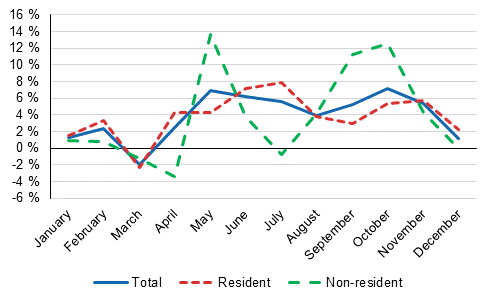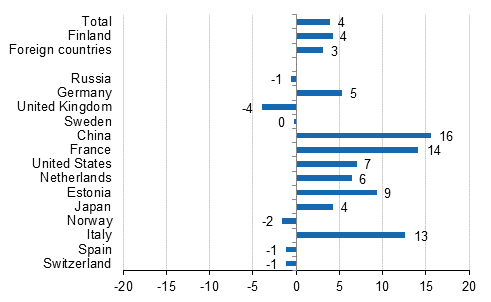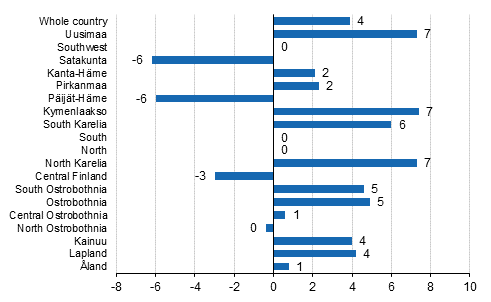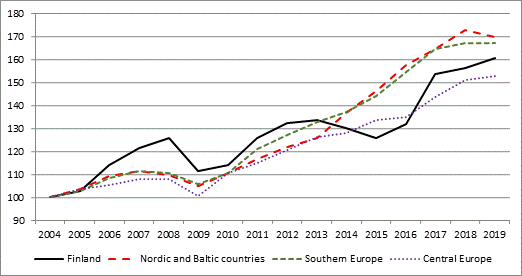Published: 8 April 2020
Demand for accommodation services grew by 3.9 per cent in 2019
In 2019, accommodation establishments in Finland recorded over 23 million overnight stays, of which domestic tourists accounted for around 16 million and foreign tourists for 7.1 million. The foreign demand for accommodation services grew by 3.1 per cent and the domestic demand grew by 4.2 per cent compared with the previous year. The total demand for accommodation services grew in total by 3.9 per cent in 2019.
In 2018, the demand for accommodation services grew moderately after the strong growth in 2017. Also in 2019, there was growth every month except for March. In the early part of the year the demand grew the least, by under two per cent. In March, demand even declined by two per cent from the previous year. However, the growth percentages started rising rapidly and by May the growth compared to the previous year was already close on seven per cent. After this the growth was more even, typically between four and six per cent. From October the growth percentages declined and in December the growth was only close on two per cent. These figures are data from Statistics Finland’s statistics on accommodation establishments and they have been collected from accommodation establishments with at least 20 beds or caravan pitches with electricity connection.
Year-on-year changes in nights spent (%) by month 2019/2018

Russians still formed the largest group of foreign visitors in accommodation establishments in 2019
Russians were still the largest group of foreign tourists in Finnish accommodation establishments in 2019. A total of 821,000 overnight stays were recorded for them, which was nearly one per cent down on the year before. The share of Russians among all overnight stays by foreign tourists remained at 12 per cent in 2019 just like in 2018. Germans came second with good 662,000 overnight stays. Their overnight stays increased by 5.3 per cent year-on-year. Third most overnight stays were recorded for British tourists, 569,000. The number was four per cent lower than in 2018. British visitors were followed by Swedes whose number of overnight stays at accommodation establishments was 558,000. However, overnight stays by Swedish tourists decreased by 0.3 per cent compared with 2018.
Nearly 384,000 overnight stays were recorded for Chinese tourists, which made them the fifth largest group. Overnight stays recorded for French visitors increased by 14.1 per cent and totalled good 342,000 at accommodation establishments. Among the most important countries of inbound tourism to Finland, the biggest growth percentages came from China, France and Italy. Overnight stays by Chinese tourists grew by 15.6 per cent. Overnight stays by French tourists increased by 14.1 per cent and they amounted to good 342,000. The number of overnight stays by Italian visitors was 12.6 per cent up on the previous year, but their stays remained at around 180,000 nights.
Finnish accommodation establishments recorded altogether good 1.2 million overnight stays for Asians in 2019. Overnight stays by Chinese and Japanese visitors covered 50.3 per cent of all overnight stays of the whole of Asia. Nearly 883,000 overnight stays were recorded for the Nordic countries, which was 0.6 per cent up on the year before. Examined by continent, the biggest growth percentage came from Asia, 13.5 per cent. In all, 6.0 per cent more overnight stays were recorded for visitors from EU countries than in 2018, the number of nights rising to 3.2 million. Tourism from America increased by 8.9 per cent and overnight stays amounted to good 437,000. Overnight stays recorded for African visitors numbered nearly 30,000 in 2019, which was 3.3 per cent down from 2018.
Change in overnight stays 2019/ 2018, %

Number of nights spent at hotels totalled good 18.4 million in 2019
In 2019, the total number of nights spent in hotels was good 18.4 million, which was 4.1 per cent higher than in 2018. In total, 12.6 million overnight stays were recorded for resident tourists and around 5.9 million for non-resident tourists. The overnight stays of resident visitors increased by 4.8 per cent and those of non-resident visitors by 2.6 per cent from 2018. Overnight stays at hotels covered almost 80 per cent of all overnight stays at accommodation establishments. The share of foreign tourists of overnight stays in hotels was 32 per cent and 31 per cent of all overnight stays at accommodation establishments.
The occupancy rate of hotel rooms for the whole country was 56.1 per cent in 2019. One year earlier it was 55.4 per cent. The average price of a hotel room has been growing since 2011, when the average price was EUR 88. In 2019, the average price of a hotel room was EUR 111.
Hotel room occupancy rate and the monthly average price in 2018 and 2019

Regional development of overnight stays in 2019
In Mainland Finland, the growth in overnight stays in 2019 was biggest in Southwest Finland, where 7.6 per cent more overnight stays were recorded than in 2018. In North Karelia, overnight stays went up by 7.3 per cent. In Kainuu, overnight stays grew by around four per cent, in South Savo 1.1 per cent and in Uusimaa by around 7.3 per cent. In South Karelia, overnight stays grew by six per cent, in Kanta-Häme 2.1 per cent and in Lapland by around 4.2 per cent. The biggest relative drop in demand was measured in Satakunta, where overnight stays decreased by 6.2 per cent. Overnight stays decreased in Päijät-Häme by six per cent and stays also slightly decreased in South Ostrobothnia and Central Finland compared with the previous year. In the other regions overnight stays increased slightly or remained on the same level as in 2018.
In absolute numbers, overnight stays in accommodation establishments increased most in Uusimaa, where good 478,000 more overnight stays were recorded, and in Lapland, where overnight stays grew by almost 126,000 from 2018.
The share of overnight stays by foreign visitors in all overnight stays was almost 46 per cent in the region of Uusimaa, and over 52 per cent in Lapland. The share of overnight stays by non-resident tourists in South Karelia was around 31 per cent. The share was around 21 per cent in Ostrobothnia and around 22 per cent in South Savo. In Uusimaa, Russians maintained their top position among all tourists. Accommodation establishments recorded around 277,000 overnight stays for them and good 259,000 for Germans. In Lapland, the biggest group of foreign visitors were British tourists for whom good 270,000 overnight stays were recorded.
Change in overnight stays by region 2019/2018,%

Growth in overnight stays by foreign visitors in Finland higher than elsewhere in Europe in 2019
In 2019, overnight stays by foreign visitors recorded in Europe was 0.5 per cent higher than in the previous year, while a growth of 3.1 per cent was attained for foreign visitors in Finland. In our neighbouring regions, the Nordic and Baltic countries, overnight stays by foreign visitors decreased by 1.7 per cent, while the growth amounted to 1.4 per cent in Central Europe. In Southern Europe, overnight stays remained on the same level. In the 2010s, overnight stays by foreign visitors in Europe have grown on average by around 4.6 per cent per year and in Finland on average by 3.9 per cent per year. In Finland, the development of overnight stays by foreigners was negative in 2014 to 2015.
Nights spent by non-residents in Europe (2004 = 100)

Overnight stays by resident tourists also grew elsewhere in Europe
Domestic overnight stays grew in Finland by 4.2 per cent and in Europe by 4.0 per cent in 2019. In our neighbouring regions of Nordic and Baltic countries, the growth in domestic overnight stays remained at 1.4 per cent. In Central Europe, domestic overnight stays grew by 5.3 per cent and in Southern Europe by 1.9 per cent. Over the 2010s, domestic overnight stays have grown in Europe yearly by an average of 2.7 per cent and in Finland by 1.6 per cent.
The information on overnight stays in other European countries is based on monthly data on the use of capacity at European accommodation establishments collected by Eurostat.
Nights spent by residents in Europe (2004 = 100)

Number of accommodation establishments almost unchanged, room and bed capacity grew in 2019
In 2019, the number of accommodation establishments contained in the statistics grew by two and the room capacity increased by 358 rooms and the number of beds by 836 beds. The capacity grew in hotels, while the number of camping sites and other accommodation establishments went down compared with 2018. Statistics Finland’s register of accommodation establishments has been updated throughout the year with new and closed establishments and permanent changes in capacity in 2019.
In 2019, the statistics covered a total of 1,374 accommodation establishments: 682 hotels, 112 guest houses, 315 holiday villages, 215 camping sites and 50 hostels. Holiday villages of hotel calibre are included in hotels. The accommodation establishments had in total 70,029 rooms (or cottages) with a total of 173,504 beds. In addition to the room and bed capacity, the accommodation establishments had 18,901 caravan pitches with electricity connection, 14,686 of which were located at camping sites.
When the capacity of accommodation establishments is viewed according to the number of rooms, the statistics contained 985 establishments with fewer than 50 rooms and 389 establishments with at least 50 rooms in 2019. Measured by bed capacity, there were 904 establishments with fewer than one hundred beds and 470 establishments with at least one hundred beds.
In 2019, there were 1,112 accommodation establishments that were open year round and 262 establishments that were open part of the year; these were mostly camping sites.
Source: Accommodation Statistics. Statistics Finland
Inquiries: Sofia Pitkänen 029 551 3556, Ossi Nurmi 029 551 2984, liikenne.matkailu@stat.fi
Director in charge: Mari Ylä-Jarkko
Publication in pdf-format (522.2 kB)
- Tables
-
Tables in databases
Pick the data you need into tables, view the data as graphs, or download the data for your use.
Appendix tables
- Appendix table 1. Capacity and its utilization in 2019 (8.4.2020)
- Appendix table 2. Nights spent in all establishments in 2019 (8.4.2020)
- Appendix table 3. Hotel capacity and capacity utilization in 2019 (8.4.2020)
- Appendix table 4. Nights spent in hotels in 2019 (8.4.2020)
- Appendix table 5. Visitor arrivals and nights spent by country of residence in 2019 (8.4.2020)
- Appendix table 6. Nights spent in all establishments by month in 2019 (8.4.2020)
- Appendix table 7.1. Nights spent by non-residents and annual change (%) in all establishments in 2019 (8.4.2020)
- Appendix table 7.2. Nights spent by non-residents and annual change (%) in all establishments in 2019 (8.4.2020)
- Appendix table 8.1. Nights spent by non-residents and annual change (%) in hotels in 2019 (8.4.2020)
- Appendix table 8.2. Nights spent by non-residents and annual change (%) in hotels in 2019 (8.4.2020)
- Appendix table 9.1. Capacity of accommodation establishments and capacity utilization by type of establishment in 2019 (8.4.2020)
- Appendix table 9.2. Capacity of accommodation establishments and capacity utilization by type of establishment, May-August 2019 (8.4.2020)
- Appendix table 10.1. Capacity of accommodation establishments by type of establishment in 2019 (8.4.2020)
- Appendix table 10.2. Capacity of accommodation establishments by opening season in 2019 (8.4.2020)
- Appendix table 10.3. Capacity of accommodation establishments by number of bed-places in 2019 (8.4.2020)
- Appendix table 10.4. Capacity of accommodation establishments by number of rooms in 2019 (8.4.2020)
Updated 8.4.2019
Official Statistics of Finland (OSF):
Accommodation statistics [e-publication].
ISSN=1799-6325. 2019. Helsinki: Statistics Finland [referred: 7.12.2025].
Access method: http://stat.fi/til/matk/2019/matk_2019_2020-04-08_tie_001_en.html

